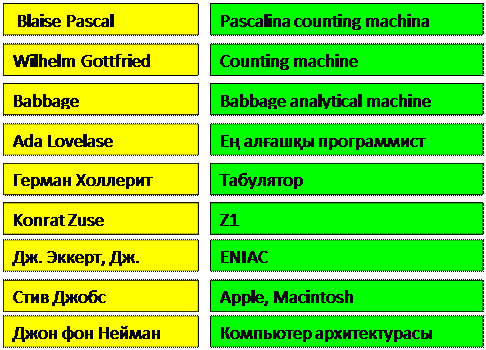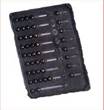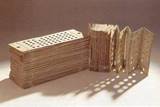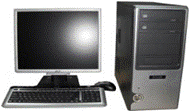
Сабақтың тақырыбы: §2 Есептеуіш техникасының даму тарихы
Осы қолжеткізетін оқу мақсаттары: 6.1.1.1- есептеу техникасының дамуының тарихы мен перспективасы жөнінде әңгімелеу;
Сабақтың мақсаты:
Барлық оқушы: Ежелгі есептеу құрылғылары мен ХХ ғасырдағы есептеу құрылғыларын атай алады;
Есептеу техникасының дамуында маңызды рөл атқарған тұлғаларды және олардың өнер табыстарын кезеңдері бойынша ажыратады;
Кейбір оқушылар: Кейінгі буын компьютерлерін алдыңғы буын компьютерлерімен салыстырып, артықшылықтарын көрсетеді;
«Есептеуіш техникасының даму тарихы»
сабағына әдістемелік нұсқаулық
Аталған сабақты оқу үшін қажетті алғашқы білімдер: 5 сыныпта компьютер құрылғылары және оның тағайындалуы (процессор және қатқыл диск), информатика кабинетіндегі қауіпсіздік техникасы мен тәртіп ережелері; «эргономика» түсінігі.
6.1А Компьютерлік жүйелер мен желілер бөліміндегі алғашқы сабақ және жаңа тақырыпты оқудың сабағы болып табылады.
Осы сабақ оқу жылдың алғашқы тақырыбы болып табылады және эргономика сұрақтарын шешуіне арналған (соның ішінде, максималды жайлылық және жұмыс тиімділігі үшін жұмыс орнын ұйымдастыру).
Осы сабақта оқушылардың алатын негізгі теориялық білімдері.
Сабақтың барлық кезеңдерінде презентацияны қолданыңыз.
Үй тапсырмасын «Бұрыштар» әдісін қолдануға болады.
Бес бұрышқа сұрақтар ілінеді. Таратпа қағаздарға жауаптарын жазып іліп кетеді.
1. Компьютермен жұмыс барысында іске асыруға болатын әрекеттер
2. Компьютермен жұмыс барысында іске асыруға болмайтын әрекеттер
3. Компьютермен жұмыс барысында жасалатын жаттығулар
4. Алғшқы медициналық көмек көрсету әдістері
Ортақ орта құру. Тақырыпты анықтау үшін видеролик ұсыну.
1. Миға шабуыл/Warm-up activity (speaking-listening)

https://www.youtube.com/watch?v=xrUvFJWlYCY
Видеорликтен алған мәліметті қолдана отырып қандай кезеңдерге бөлуге болатындығын сөзге тартып 3 топқа бөлінеді. Топқа өз қалауыңызша үш түрлі түспен топқа бөліңіз.
1 топ. Механикалық кезең
2 топ. Қолдық кезең
3 топ. Сандық компьютер
Топтық жұмысқа төмендегі тапсырма беруге болады. Әріптерге сай пайда болу кезеңіне қарай құрылғылардың аттарын құрастыру
Тапсырма 1-1 (Writing activity)
Пайда болу кезектілігіне қарай есептеу техниканың құрылғыларын атаңыз?
|
С Т Е П Л |
Жауап: Саусақтық есеп Таяқшалар, түйіншек, таңба Абак есептегіш тақта Есепшот Позициялық жүйе Логорифмдік сызғыш |
2. Терминдермен жұмыс
Тапсырма 2-1 (Vocabulary activity) Classify the following
Кесте 1. Сабақтың тақырыбы
|
Е |
М |
Т |
Н |
К |
Н |
|
Д |
Е |
Т |
У |
Х |
|
|
С |
У |
Х |
Р |
І |
Ы |
|
А |
Е |
Е |
И |
А |
Ш |
|
Т |
П |
А |
И |
Ы |
Ң |
Түс бойынша бөлінген топ түс бойынша тізбек ретімен жоғарыдан төмен қарай әріптерден сөз құрау керек. Әр топта төмендегі сөздер шығу керек. Осы сөздерден сөйлем құрап сабақтың тақырыбын анықтайды.
1 топ Механикалық кезең – Есептеуіш
2 топта Қолдық кезең– Техниканың
3 топта Сандық компьютер– Даму тарихы
3. «Есептеуіш техника» тақырыбына қатысты ағылшын термині.
|
Computer engineering |
Есептеуіш техника |
|
Abacus |
Абакус |
|
Napier’s Bones |
Непер таяқшалары |
|
The Calculating Clock |
Шикардтың есептеуіш сағаттары |
|
Wheel Calculator |
Доңғалақ калкулятор (Паскалин) |
|
Charles Babbage’s Analytical Engine |
Бэббидждің аналиткалық мәшинесі |
|
Hollerith Tabulating |
Холлерит үстелі |
Төмендегі тапсырманы екі түспен шығару керек. Құрылғыларды оның авторларымен сәйкестендіреді.
4. Тапсырма 3-1. Match
 |
5. Тапсырма 4. Кестедегі бос ұяшықтарды толтырыңыз/ Fill in the gaps
|
Не? |
Қайда? |
Қашан? |
|
|
АҚШ |
1945 |
|
|
|
|
|
Абак |
|
|
|
Логарифмдік сызғыш |
|
1654 |
|
|
|
1673 |
|
|
|
XIX ғасыр |
|
Бэббидждың аналитикалық машина |
|
|
|
|
СССР |
1967 |
«Ыстық орындық»
қосымша1.1 Есептеу құрылғылары.










6. Қажетті сөзді орналастыр.
|
Abacus, Pascaline, Pascaline, Leibniz's mechanical, abacus, Charles Babbage, Augusta Ada King, Pascaline, Herman Hollerith, Hollerith's machine, abacus, Blaise Pascal, |
Computer History And Development
The abacus was emerged about 5,000 years ago in Asia Minor and is still in use today, may be considered the first computer. This device allows users to make computations using a system of sliding beads arranged on a rack. Early merchants used the abacus to keep trading transactions. But as the use of paper and pencil spread, particularly in Europe, the abacus lost its importance. It took nearly 12 centuries, however, for the next significant advance in computing devices to emerge. In 1642, Blaise Pascal (1623-1662), the 18-year-old son of a French tax collector, invented what he called a numerical wheel calculator to help his father with his duties. This brass rectangular box, also called a Pascaline, used eight movable dials to add sums up to eight figures long. Pascal's device used a base of ten to accomplish this. For example, as one dial moved ten notches, or one complete revolution, it moved the next dial - which represented the ten's column - one place. When the ten's dial moved one revolution, the dial representing the hundred's place moved one notch and so on. The drawback to the Pascaline, of course, was its limitation to addition.
In 1694, a German mathematician and philosopher, Gottfried Wilhem von Leibniz (1646-1716), improved the Pascaline by creating a machine that could also multiply. Like its predecessor, Leibniz's mechanical multiplier worked by a system of gears and dials. Partly by studying Pascal's original notes and drawings, Leibniz was able to refine his machine. The centerpiece of the machine was its stepped-drum gear design, which offered an elongated version of the simple flat gear
The real beginnings of computers as we know them today, however, lay with an English mathematics professor, Charles Babbage (1791-1871). By 1812, Babbage noticed a natural harmony between machines and mathematics: machines were best at performing tasks repeatedly without mistake; while mathematics, particularly the production of mathematics tables, often required the simple repetition of steps. The problem centered on applying the ability of machines to the needs of mathematics. Babbage's first attempt at solving this problem was in 1822 when he proposed a machine to perform differential equations, called a Difference Engine. Powered by steam and large as a locomotive, the machine would have a stored program and could perform calculations and print the results automatically. After working on the Difference Engine for 10 years, Babbage was suddenly inspired to begin work on the first general-purpose computer, which he called the Analytical Engine. Babbage's assistant, Augusta Ada King, Countess of Lovelace (1815-1842) and daughter of English poet Lord Byron, was instrumental in the machine's design. Also, Lady Lovelace's fine understanding of the machine allowed her to create the instruction routines to be fed into the computer, making her the first female computer programmer. In the 1980's, the U.S. Defense Department named a programming language ADA in her honor..
In 1889, an American inventor, Herman Hollerith (1860-1929), also applied the Jacquard loom concept to computing. His first task was to find a faster way to compute the U.S. census. The previous census in 1880 had taken nearly seven years to count and with an expanding population, the bureau feared it would take 10 years to count the latest census. Unlike Babbage's idea of using perforated cards to instruct the machine, Hollerith's method used cards to store data information which he fed into a machine that compiled the results mechanically. Each punch on a card represented one number, and combinations of two punches represented one letter. As many as 80 variables could be stored on a single card. Instead of ten years, census takers compiled their results in just six weeks with Hollerith's machine. In addition to their speed, the punch cards served as a storage method for data and they helped reduce computational errors. Hollerith brought his punch card reader into the business world, founding Tabulating Machine Company in 1896, later to become International Business Machines (IBM) in 1924 after a series of mergers. Other companies such as Remington Rand and Burroghs also manufactured punch readers for business use.
Скачано с www.znanio.ru
Материалы на данной страницы взяты из открытых источников либо размещены пользователем в соответствии с договором-офертой сайта. Вы можете сообщить о нарушении.